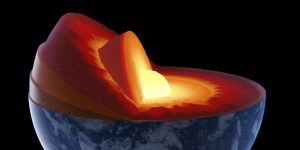
New geochemical research indicates that existing theories of the formation of the Earth may be mistaken. The results of experiments to show how zinc (Zn) relates to sulphur (S) under the conditions present at the time of the formation of the Earth more than 4 billion years ago, indicate that there is a substantial quantity of Zn in the Earth’s core, whereas previously there had been thought to be none. This implies that the building blocks of the Earth must be different to what has been supposed. The work is presented at the Goldschmidt geochemistry conference in Paris.
The researchers, from the Institut de Physique du Globe de Paris (IPGP) melted mixtures of iron-rich metal and silicate compounds, containing Zn and S, at high temperatures and pressures up to 80 GPa and 4100K* to experimentally simulate core-mantle differentiation at the time of the Earth’s formation. They then measured how these elements were distributed (partitioned) between the core and mantle of their experiments. When they fed their results into computer models of the Earth’s formation, they found that none of the canonical models can sufficiently reproduce the S/Zn ratio of the present-day mantle. This means that the current estimates of the Earth’s composition, including its core, need to be modified, and therefore the way the core and mantle — i.e. the Earth — formed may also need to be revised.
“Most theories are based on the Earth being formed from only two types of stony meteorite, the CI chondrites or enstatite chondrites. However, this new work indicates that the Earth needs to have formed from a more S-poor source; in terms of the geochemistry, the best candidate for this material is the metal rich CH chondrites,” said Brandon Mahan (Institut de Physique du Globe de Paris).
“CH chondrites were first classified in 1985, and only a few dozen examples have been identified. They are rich in metallic iron and poor in easily vaporized elements, which indicates formation at very high temperatures, but they also contain a few percent of water-bearing minerals, which paradoxically indicates low temperatures.
This means that the CH chondrites — much like the Earth — have a very complex formation history which has given them features from both extremes of hot and cold. If our results are valid, this indicates that the building blocks of the Earth may be a bit more exotic than we thought” Existing theories of the Earth’s formation are largely based on geochemistry. One of the major geochemical clues to the Earth’s formation lies in the way elements such as Zn and S in meteorites are associated in a relatively well-known ratio, meaning that if you know the amount of Zn in a meteorite, you can estimate the amount of S. “We decided to test if that ratio was the same for the growing Earth as it is today using various possible source materials.,” said Brandon Mahan.
“We found that under conditions similar to those estimated when the Earth formed, Zn has a tendency to be distributed between the core and mantle differently than we had thought, i.e. there will be a significant amount of it bound up in the Earth’s core. Based on previous models, if we can place more Zn in the core, then by association you place more S in the core as well, much more in fact than most current observations suggest.
Most leading estimates cap the amount of sulphur in the Earth’s core at around 2%. If this is true, then using most known meteorites as a source material for Earth puts the S/Zn ratio of the mantle way above current accepted values, because too much S ends up in the mantle, indicating that perhaps the Earth cannot be made from any of the solar system materials that have previously been proposed as its source material.
But if the building blocks of the Earth were something like the CH Chondrites, this could give us an Earth pretty similar to the one we see today.”
*For comparison, 80GPa is around x1.5 the typical pressure needed to synthesise diamonds. The temperature of the surface of the Sun is around 5800K.
Note: The above post is reprinted from materials provided by Goldschmidt Conference.










